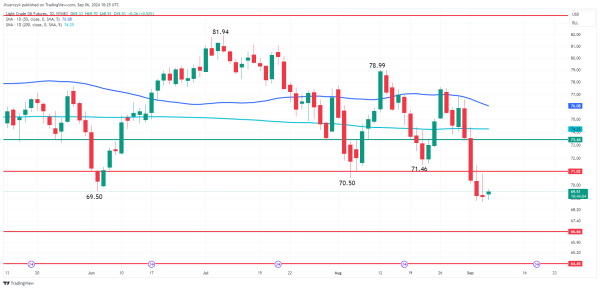Oil News: Oil Prices Stabilize Near 14-Month Low, Demand Concerns Linger
Oil Prices Slump to 14-Month Low
Oil prices held steady on Friday as traders awaited U.S. employment data, but Brent and WTI crude were set for significant weekly losses. Both benchmarks were poised to close at their lowest levels in months, with Brent crude facing a 7% decline and WTI looking at a 6% drop.
At 10:40 GMT, Light Crude Oil futures are trading $69.46, up $0.31 or +0.45%.
Demand Concerns Overshadow Supply Cuts
Market sentiment remains bearish due to persistent worries about weakening demand in the U.S. and China, the world’s top oil consumers. Economic indicators have shown mixed signals, with slowing growth in private sector jobs and steady service sector activity suggesting a cooling U.S. labor market.
A significant 6.9 million-barrel draw from U.S. crude inventories provided some support, but fears over future demand appear to outweigh this bullish data. The inventory decline had little lasting effect on prices, highlighting the market’s focus on demand-side factors.
OPEC+ Action and Libyan Supply
OPEC+ agreed to delay planned oil output increases for October and November, potentially tightening global oil supply by 100,000 to 200,000 barrels per day. However, the market remains skeptical about OPEC+’s long-term influence on prices, given the group’s ample spare capacity.
Libya’s ongoing political tensions have disrupted its oil output, providing temporary support for global oil prices. However, a potential resolution of internal conflicts could lead to increased Libyan supply, further pressuring the market.
U.S. Economic Uncertainty
Conflicting U.S. economic data adds to market uncertainty. While jobless claims fell, private job growth hit a 3.5-year low in August. Investors remain cautious ahead of the Federal Reserve’s next policy meeting, where interest rate cuts are anticipated.
Analysts at UBS noted that the Fed’s Beige Book report signals slowing economic growth and rising recession risks, factors that could further dampen oil demand.
Market Forecast
The short-term outlook for oil prices remains bearish. Persistent demand concerns from major economies, coupled with OPEC+’s limited ability to support prices in the long term, are likely to keep oil prices under pressure. While the delay in supply hikes and larger-than-expected U.S. inventory draw offer some support, the overall sentiment remains negative as traders await further economic data and developments in global supply.
Technical Analysis

Trading on the bearish side of a major retracement zone at $71.02 to $73.44 makes Light Crude Oil futures vulnerable to a steep decline into the next support at $66.66.